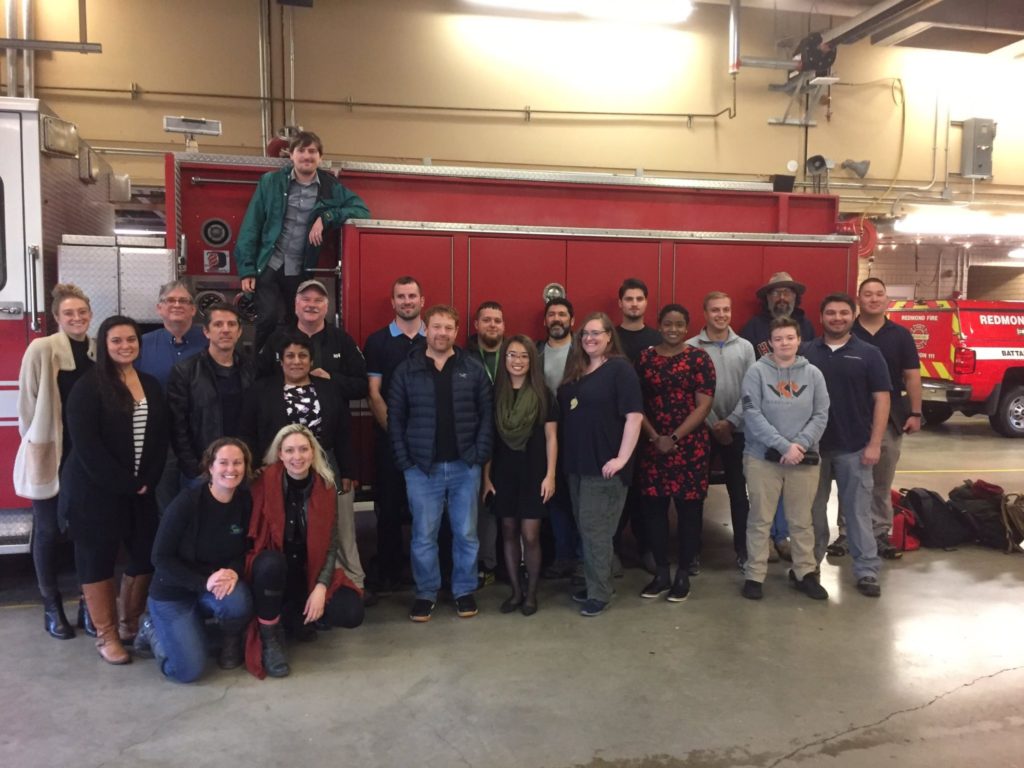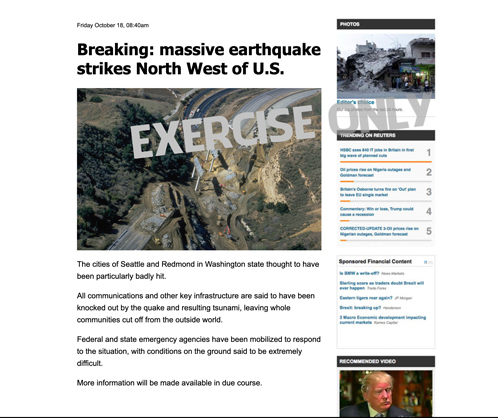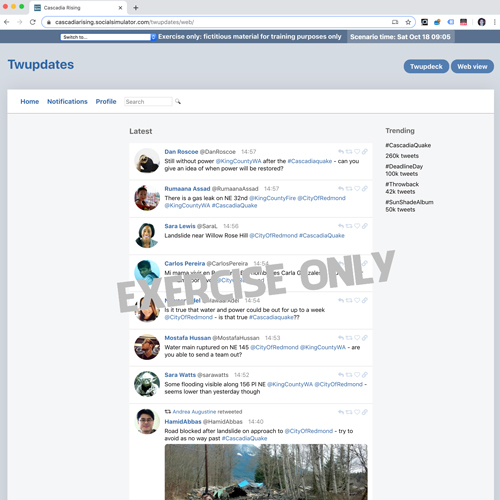We were asked by the City of Redmond to support in the delivery of the Cascadia Rising Solutions emergency planning exercise.

The aim of the exercise, run over two days in late October 2019, was to test the decision-making and public information response to a category 9.0 earthquake impacting the Pacific north west of the U.S following tectonic activity within the Cascadia Subduction Zone.
Needless to say, 'The Big One’ would result in widespread damage to key infrastructure – not to mention significant human impacts - and we were tasked with bringing this catastrophic scenario to life using our simulation platform.
Over the course of two days we tested Public Information Officers (PIOs) from a variety of state agencies - who came together to form the Joint Information Centre (JIC) to coordinate the communications response to the disaster - on their digital response to the disaster.

Breaking news as Cascadia Rising gets underway - fictitious material created for the purposes of the exercise
How we tested
Our Social Simulator platform allows us to re-create social media channels, websites, news coverage - including TV bulletins, and emails from colleagues and partners and update them as the crisis unfolds. Participants can update their channels and respond as they would in real life, but safe in the knowledge that all the online activity takes place in a private space. Our role-players engage just as the public would in a real emergency. We make it as realistic as possible to ensure the sternest test of PIOs and other team members.
This video shows how the exercise unfolded:
Social Simulator Inc: Cascadia Rising exercise from Social Simulator on Vimeo.
What we tested
Our role was to put the PIOs through their paces, with a specific focus on:
- The speed with which PIOs were able to engage with a range of audiences using social media
- The consistency with which JIC members were able to communicate and coordinate their efforts
- The information sharing capabilities of social media responders and wider incident decision-makers to inform the humanitarian response effort

Twupdates feed from the Cascadia Rising exercise. Participants can send twupdates, as well as reply to and share updates from other participants and our role-players who post as members of the public.
Five takeaways
- Leadership is vital in a JIC as within any other team: when a high-impact disaster strikes and a JIC is mobilized, PIOs from an array of agencies will be convened to form a team to coordinate the communications response. This means different communications functions coming together from teams that may never have even met before, let alone worked together. As such it is critical that a JIC leader is appointed to delegate responsibilities, to ensure that key actions are completed and remain aligned to wider response objectives, and to act as a liaison point with the Emergency Coordination Center (ECC)
- As well as providing a vital means of engaging with priority audiences, social media provides invaluable intelligence for the wider humanitarian response: part of our brief was to test how effectively JIC social media responders monitored our pseudo media feeds to locate members of the public who were trapped or had been injured in the disaster, and shared their whereabouts with the ECC, for these to be relayed to on-the-ground search and rescue teams.
- Creating visual, shareable content can help get your message to the audiences that need them most: although the need for speed in a crisis or disaster is paramount for social media responders, it’s worth taking time to create visually compelling content, such as infographics and maps to help tell your story. Whether it be to provide the location of emergency shelters, functioning medical facilities or no-go zones, visuals produced using simple tools such as Canva and Piktochart can provide an effective means of communicating complex information, in a way that enables people to share it across channels and platforms.
- #Hashtags are used in most crises and issues, but are vital tools for PIOs in a disaster: in situations where there is widespread devastation and disruption, there is likely to be an overwhelming volume of contacts to local agencies across channels. Establishing a main response hashtag quickly, which is then signposted from, and used by, all JIC member social accounts, can provide an invaluable means of audiences locating important information related to the disaster. Likewise, this can help agencies to find and share important information.
- Be prepared to make the most of not being able to do anything… The first phase of the exercise tested how members of the JIC managed a complete communications blackout resulting from the earthquake. No power. No internet. Nothing. Responders used this time for planning their response and getting organized. Messages were drafted and adapted for different social media channels, and visuals produced so that, once telecommunications were restored, the team could commence engagement efforts without delay.
In the last 12 months we’ve tested how communications teams and PIOs respond to a wide range of emergency scenarios, including biohazard incidents, active shooter attacks and natural hazards. If you and your team are in the process of commissioning an emergency planning exercise or disaster response drill get in touch to find out how we can help you to bring it to life online.


